#Food Additives
Explore tagged Tumblr posts
Text
instagram
Hell yeah, stop corporations poisoning the World! I won't even tag WHO because they're a bunch of lying, sinister mongrels
9 notes
·
View notes
Text
Jeff Goldblum warning us in Jurassic Park that cloning dinosaurs is raping mother nature was apparently an instruction manual and not a warning.

"Colossal Biosciences, a biotechnology company founded in 2021, is working to genetically resurrect the woolly mammoth by combining its genes with Asian elephant DNA. The company's goal is to create a hybrid species, called a "mammophant", that will look and behave like a woolly mammoth. Colossal plans to use cloning techniques similar to those used to create Dolly the sheep in 1996, inserting genetically edited cells into an elephant egg that would then be gestated by a surrogate elephant. The company has said it intends to complete the project by 2027."

Exploitative KKKapitalism = Eating like 💩 in the neighborhood! "Studies have shown that the prevalence of fast-food restaurants is positively correlated with the percentage of Black residents in urban neighborhoods in the U.S. Similar trends have been found for liquor stores."
$Anything for a Dollar$
"While dollar stores can fill a need in low-income neighborhoods, they are often regarded as predatory businesses that harm communities more than they benefit them, due to very low wages, displacing other grocery options while failing to sell fresh food, store design that increases the rate of armed robberies, and OSHA and FDA violations that put customers and employees at risk."
Who Needs Fresh Food?
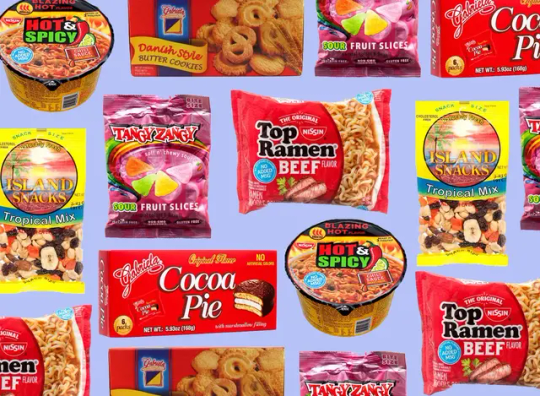
"There are no fresh vegetables, fruits, or meats in most dollar stores. And yet, as limited as their offerings are, dollar stores are now feeding more Americans than Whole Foods is, and they’re multiplying rapidly. Since 2011, the number of dollar stores nationwide has climbed from about 20,000 to nearly 30,000. There are now more dollar stores than Walmart and McDonalds locations combined."
Dollar Tree Customers = Permanent Underclass
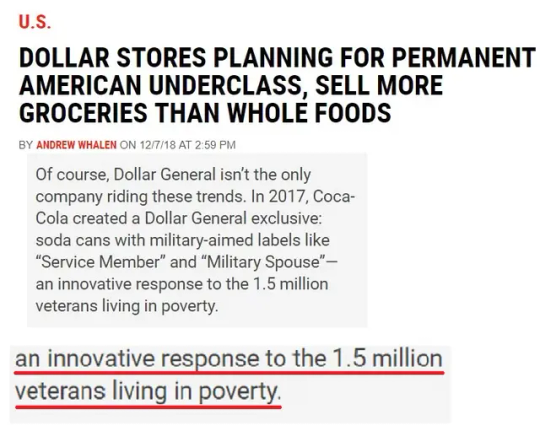
"In their latest annual reports, Dollar General and Dollar Tree say they have identified thousands of new locations for dollar stores. The two chains are planning to expand their combined empires to more 50,000 outlets."
“Essentially what the dollar stores are betting on in a large way is that we are going to have a permanent underclass in America,” Garrick Brown, a researcher with the commercial real estate firm Cushman & Wakefield, told Bloomberg last year.
“The economy is continuing to create more of our core customer,” Dollar General chief executive Todd Vasos told investors last year.

"More than one-third of American adults, and 48 percent of African American adults, are obese."
13% of the US population is Black, and 48% of Black Americans are obese.
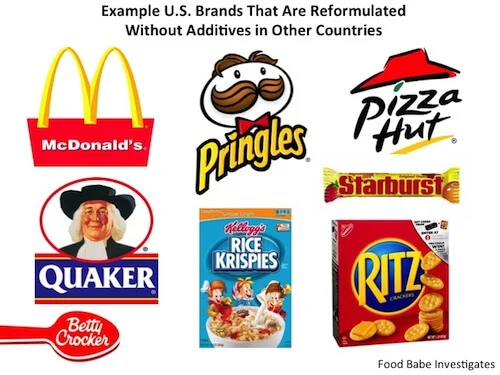
"Look at the pharmaceutical companies. In my neighborhood, there is a fast-food restaurant on every block, from Wendy’s to Kentucky Fried Chicken to Popeye’s to Little Caesar’s Pizza. Now drugstores are popping up on every corner, too. So you have the fast-food restaurants that of course cause the diet-related diseases, and you have the pharmaceutical companies there to fix it."

"If you give people access to really good food and a living-wage job, someone is going to lose money. As long as people are poor and as long as people are sick, there are jobs to be made. Follow the money."

"I talk about power, and how power is a drug and power over people is a drug and it’s hard to give up."
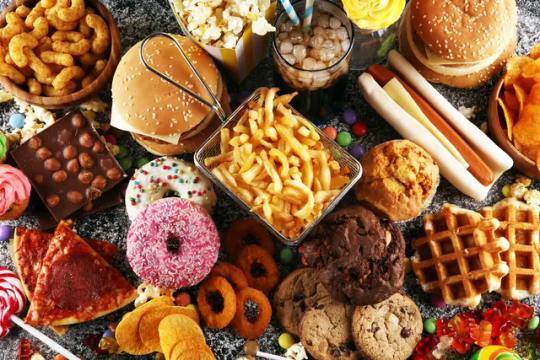
"A substantial body of evidence indicates that diet, toxic metals, food additives, insufficient nutrients, food allergy, lack of exercise can all contribute to criminal behavior. Evidence is mounting that a good diet makes a positive difference when working with some offenders."

"Our estimates imply that the 42% drop in the natural gas price in the late 2000s, mostly driven by the shale gas boom, averted 12,500 deaths per year in the United States."

"Participants (60.55%) experienced unexpected or increased medical expenses (17.69%), job loss (13.64%), pay reduction (11.85%), and death of a family member (9.09%). Pay reduction and increased debt were associated with moderate hunger; death of a family member, pay reduction, and increased debt were associated with severe hunger."
Lung Cancer to Avoid Severe Hunger

"In unadjusted models, annual household income <$15,000, non-urban residence, lack of health insurance, unstable housing, heavier food pantry reliance, fair or poor adult health, adult anxiety, and adult smoking to reduce hunger pangs were all positively associated with VLFS-C."
Fast Food = Fast Death
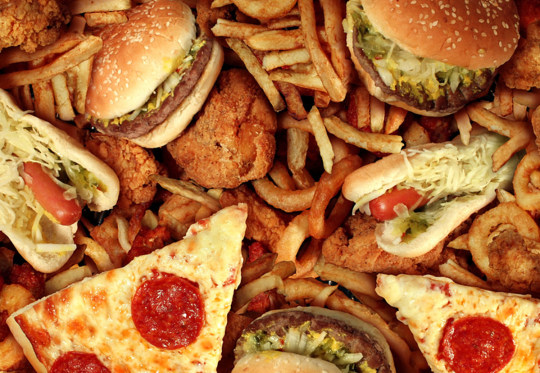
"Survey respondents had 8 ± 7 fast-food outlets within 2 miles of their home. Individuals living in close proximity to fast-food restaurants had higher BMIs, and lower fruit and vegetable consumption."
Happy Meal = Psychiatric Distress & Violence

"Consumption of fast food has been linked to psychiatric distress, violent behaviors, and impulsivity in adolescents."

"The analysis found that liquor stores are disproportionately located in predominantly black neighborhoods, even after controlling for census tract socioeconomic status."

"At equal levels of poverty, Black neighborhoods had the fewest supermarkets."
#anti capitalism#socialism#social justice#black lives matter#anti capitalist#corporatism#cronyism#socialist#food insecurity#racial justice#predatory#exploitation#fast food#addiction#dollar store#poverty#late stage capitalism#obesity#big pharma#globalist agenda#living wage#food addiction#food additives#low income#alcohol
43 notes
·
View notes
Text



I discovered these interesting scale insects on my prickly pear cactus (opuntia).
It turns out these are cochineal insects (Dactylopius coccus), the source of the natural dye carmine. You can see some of this pigment in the third picture (purple splotch) where the bugs may have been injured. Carmine, aka crimson lake, is frequently found in cosmetics (blush and lipstick) and food (ice cream, yogurt, soft drinks, sausage, and candy). Farming these bugs began as early as 700 BC in South America, and carmine has been used by many indigenous cultures to dye textiles and create artwork.
While mature females are about 25% carminic acid, it still takes tens of thousands of them to produce one pound of pigment.
If I get enough of these, I may try making some dye myself XD
#cochineal#cochineal insects#scale insects#you’ve probably eaten bugs at some point#carmine#crimson lake#food additives#dye#nature#bugs#nature photography#biodiversity#animals#inaturalist#arthropods#entomology#insect appreciation#insects#dactylopius coccus#TIL#random facts#educational#interesting facts#opuntia#bugblr#eat bugs#nom nom nom#hemiptera#parasite
10 notes
·
View notes
Text
Hooked: Food, Free Will, and How the Food Giants Exploit Our Addictions

Hooked: Food, Free Will, and How the Food Giants Exploit Our Addictions
From the author of Salt Sugar Fat comes a “gripping” (The Wall Street Journal) exposé of how the processed food industry exploits our evolutionary instincts, the emotions we associate with food, and legal loopholes in their pursuit of profit over public health.
“The processed food industry has managed to avoid being lumped in with Big Tobacco - which is why Michael Moss’s new book is so important.” (Charles Duhigg, author of The Power of Habit)
I came to the question of food and addiction inadvertently with the 2013 publication of my book Salt Sugar Fat. In it, I argued that grocery manufacturers were competing with fast-food chains in a race to the bottom that rewarded profits over health.
Over the past four decades, salt, sugar, and fat had enabled the industries to engineer products that were immensely alluring. Brilliant marketing campaigns pushed the emotional buttons that convinced us to eat when we weren’t even hungry.
Yet the book tried to end on a hopeful note. Knowing all that the companies did to prop up their unwholesome products, I argued, was oddly empowering. We could use that insight to make better choices because, ultimately, we were the ones deciding what to buy and how much to eat.
Thus, the initial imperative for this book: to sort out and size up the true peril in food. To see if addiction is the best way to think about our trouble with food and eating, given what we’ve learned from other substances and habits. And to peer inside the processed food industry to see how it is dealing with what, in its view, would be a monumental threat to the power it holds over us.
Everyone knows how hard it can be to maintain a healthy diet. But what if some of the decisions we make about what to eat are beyond our control? Is it possible that food is addictive, like drugs or alcohol? And to what extent does the food industry know, or care, about these vulnerabilities? In Hooked, Pulitzer Prize-winning investigative reporter Michael Moss sets out to answer these questions - and to find the true peril in our food.
Moss uses the latest research on addiction to uncover what the scientific and medical communities - as well as food manufacturers - already know: that food, in some cases, is even more addictive than alcohol, cigarettes, and drugs.
Our bodies are hardwired for sweets, so food giants have developed fifty-six types of sugar to add to their products, creating in us the expectation that everything should be cloying; we’ve evolved to prefer fast, convenient meals, hence our modern-day preference for ready-to-eat foods. Moss goes on to show how the processed food industry - including major companies like Nestlé, Mars, and Kellogg’s - has tried not only to evade this troubling discovery about the addictiveness of food but to actually exploit it.
For instance, in response to recent dieting trends, food manufacturers have simply turned junk food into junk diets, filling grocery stores with “diet” foods that are hardly distinguishable from the products that got us into trouble in the first place. As obesity rates continue to climb, manufacturers are now claiming to add ingredients that can effortlessly cure our compulsive eating habits.
A gripping account of the legal battles, insidious marketing campaigns, and cutting-edge food science that have brought us to our current public health crisis, Hooked lays out all that the food industry is doing to exploit and deepen our addictions, and shows us why what we eat has never mattered more.
#Hooked: Food#Free Will#and How the Food Giants Exploit Our Addictions#food#food addiction#Junk food#sugar#salt#fat#sugar salt fat#food additives#public health crisis#nutrition#diet#food manufacturers
2 notes
·
View notes
Text
Công ty TNHH Thương mại và Sản xuất Đoàn Anh
https://phugiaantoan.com/
https://doananhfootech.com/
3 notes
·
View notes
Text
I think I look young because I stopped drinking milk by the glass at age 6 or 7 . It’s said that milk 🥛 had added growth hormones and stuff 🤷🏻♀️
I grew up poor so we didn’t have meat and potatoes every night. Ya know because meat has additives and what not idk 🤷🏻♀️
I wasn’t glued to a cell phone until I could pay for one myself until junior year of high school
I didn’t wear a full face of makeup until maybe 17-19. And back then what was primer and dry/oily skin lol
I wore sunscreen a lot because the smell 💯
I’ll never get that baby weight because we can’t have kids 🤷🏻♀️
And you know genetics help! I never got that grown woman’s body that people talk about 🤷🏻♀️
#this#life#millennials#food additives#food#milk#cell phones#Team no kids#30s#makeup#2000s#poor things#idk man#idk what im doing#ted talks#personal rant#body image#body shape#infertility
1 note
·
View note
Text
Common food preservative has unexpected effects on the gut microbiome
"Food manufacturers often add preservatives to food products to keep them fresh. The purpose of these preservatives is to kill microbes that could break down and otherwise spoil the food. Common additives like sugar, salt, vinegar and alcohol have been used as preservatives for centuries, but modern-day food labels now reveal more unfamiliar ingredients such as sodium benzoate, calcium propionate, and potassium sorbate.
Bacteria produce chemicals called bacteriocins to kill microbial competitors. These chemicals can serve as natural preservatives by killing potentially dangerous pathogens in food. Lanthipeptides, a class of bacteriocins with especially potent antimicrobial properties, are widely used by the food industry and have become known as "lantibiotics" (a scientific portmanteau of lanthipeptide and antibiotics).
Despite their widespread use, however, little is known about how these lantibiotics affect the gut microbiomes of people who consume them in food. Microbes in the gut live in a delicate balance, and commensal bacteria provide important benefits to the body by breaking down nutrients, producing metabolites, and—importantly—protecting against pathogens. If too many commensals are indiscriminately killed off by antimicrobial food preservatives, opportunistic pathogenic bacteria might take their place and wreak havoc—a result no better than eating contaminated food in the first place.
A new study published in ACS Chemical Biology by scientists from the University of Chicago found that one of the most common classes of lantibiotics has potent effects both against pathogens and against the commensal gut bacteria that keep us healthy."
continue reading article
#food#healthy food#food industry#gut#health#gut microbiome#food additives#food preservatives#biology#chemistry#science#bacteria#digestion#antibiotics#lantibiotics#nutrients#energy#gut health
2 notes
·
View notes
Text
I don't have any medical reasons to not have the added sugar, but I try to reduce my intake unless I'm actually meaning to have it as a treat. I also really don't like the taste of most artificial sweeteners or replacements (like Stevia) I really wish they'd just stop over-sweetening stuff.
As a corollary, why do they have to add extra caffeine to so many things, especially electrolytes? I have to limit my intake due to a heart issue and I've accidentally picked up caffeinated mixes so many times. (I'm active outdoors in the Southeast; yes, I need electrolytes).
what "no sugar added" should mean: the natural sugars of the other ingredients like fruit are the only source of sweetness in this product
what is actually means: we added a fuckton of artificial sweeteners
60K notes
·
View notes
Text
instagram
#politics#world economic forum#world health organization#bill gates#klaus schwab#food security#food additives#rfk jr#european union#Instagram
8 notes
·
View notes
Text
Ozempic Mania: Obsession & Brainwashing

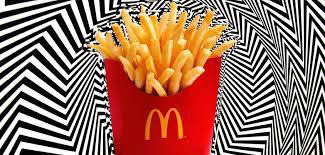
I saw a Hims & Hers commercial for compounded semaglutide during Raw on Netflix last night that really bothered & disturbed me:
youtube
In fact, it bothered & disturbed me so much that when I woke up (very early) this morning at 3:30 am it was the literal first thought I had.
Why did it bother me so much?
First of all, compounded pharmacies create copies of name brand drugs but do NOT go through FDA approval.
So, there are no rigorous quality checks & often times, these copycat drugs which are considerably cheaper than the name brand, are contaminated, improperly dosed, etc. which has resulted in poisonings, overdoses & deaths.
Hims also does not even require for individuals using their service for compounded semaglutide aka knockoff Ozempic & Wegovy as semaglutide is the active ingredient to even have a video appointment with a doctor before receiving their prescription.
All you have to do is fill out a form which does not even screen for eating disorders so all you have to do is lie about your weight & bam! You now have copycat Ozempic or Wegovy.
It's literally 1/5th of the cost that the name brand drugs cost at $250 to $300 a month for the copycat compounded version versus $1000 to $1399 a month out of pocket for the name brand.
Given that manufacturer's coupons reducing price for the name brand are only valid for a few months & insurance companies that do approve Ozempic & Wegovy, when they do, only do so for a year or two, there are millions of Americans obtaining their "miracle weight loss drug" through compounding pharmacies, online med spas, Hims & Hers, etc.
With no oversight & without even speaking to a doctor.
What could possibly go wrong?
On top of the above obvious issues, if you played the ad above, you see that unlike Novo Nordisk when they advertise Ozempic & Wegovy, literally NONE of the medications extremely adverse potential side effects are even mentioned!
Just a one line sentence of text in the corner of the screen.
Really?
When compounded semaglutide is NOT FDA approved so it does NOT have the quality checks that Ozempic & Wegovy have?
How does it make sense that pharma manufacturers have to list out all potential side effects for the drugs they market when those medications HAVE FDA approval yet compounded semaglutide is NOT FDA approved yet Hims was allowed to air this ad without any consequences?
The Hims Super Bowl ad was even worse & once again, Hims did not list ANY potential adverse side effects of GLP-1 drugs.
While the FDA wouldnt regulate or monitor this ad since its compounded, the FTC could have and SHOULD have stepped in & fined Hims or not approved the ad to air without insisting Hims include warnings of the potentially extremely adverse side effects that can occur with semaglutide.
As you can see above, that didn't happen.
Predatory, manipulative, deceptive, dishonest, preying on people's insecurities, soulless corporatists.
I have done ongoing research for the past fifteen years on overly processed foods, fast food, incidences of obesity, additives, sugar substitutes, toxins, synthetic chemicals, pesticides, herbicides, GMOs & fungicides in causing & creating America's obesity pandemic which started in 1976 & has only exponentially worsened in the fifty years since.
Funny how none of the GLP-1 hysteria even bothers to mention that 60% of food & beverage products in America contain toxic additives, synthetic chemicals, substitutes, pesticides, herbicides, fungicides, GMOs, preservatives, flavorings, colorings & excess amounts of salt, fat & sugar with minimal amounts of protein, fiber & nutrients.
The absolutely nauseating ubiquitous advertisements for Ozempic, Wegovy & Zepbound have really disturbed me with the above Hims ad during Raw on Netflix last night being a final straw so I did additional research this morning on GLP-1 drugs causing weight rebound, suppressing the body's natural ability to release GLP-1 which is the body's natural signal indicating fullness & satiety which then naturally increases individuals appetite causing extreme hunger pangs & cravings once the medications are stopped.
Additionally, the FDA recently ruled this past Friday that there is no longer a semaglutide shortage which means that compounding pharmacies have 90 days to cease & desist in making & selling compounded semaglutide.
Now, ofcourse, these pharmacies can get around this by combining semaglutide with metformin for nausea or Vitamin B12 for fatigue & then sell the combination under 503B exemption. I am also fairly certain these pharmacies will take Novo to court to sue as the compounded semaglutide is currently taken by millions of Americans who cannot afford the brand name Ozempic & Wegovy & is far too lucrative for them to just give up with this ruling.
With that said, while lawsuits can drag out in court for years & as I mentioned these pharmacies can just add metformin or Vitamin B12 to semaglutide and sell the combination under 503B exemption, the FDA no longer categorizing semaglutide as being in a shortage will probably somewhat affect the availability of compounded semaglutide where it will still be available for purchase but not as widely and easily as it has been.
In doing so, I came across extremely disturbing information that Phillip Morris — the big tobacco company — purchased several food companies in the 80s including Kraft.


All of the lies Phillip Morris told about tobacco & cigarettes not being addictive or deadly were repeated with Krafts overly processed foods & snacks.
Just like with cigarettes, while Kraft/Phillip Morris purposely designed their products to be addictive & harmful while lying to the contrary, the exact same pattern was repeated with Krafts overly processed food & snacks.

The same attorneys that were used to deny cigarettes harmful addictive qualities for decades before Phillip Morris finally admitted the truth for the first time were utilizing the exact same tactics pre-emptively & internally with overly processed junk food & snacks that Kraft produced.
The attorneys, marketing teams & executives foresaw similar warning labels in coming decades for junk food as well as lawsuits — exactly what happened with tobacco — & utilized all the same disgusting deceptive practices, lies, industry funded research to claim their products were safe when the opposite was true & aggressive lobbying of lawmakers to keep warning labels off of their products & to minimize regulation attempts — the exact same playbook they had utilized with their tobacco products.
Just like how Phillip Morris finally admitted cigarettes were addictive in 2000 after decades of vociferous denials, industry funded research & studies & aggressive lobbying to the contrary — recall that the NFL who utilized the same law firm as Phillip Morris for the landmark concussion lawsuit & 2013 settlement followed the exact same corporatist denial playbook — decades of denying the dangers of concussions, returning to play after receiving a concussion, second impact syndrome & long term effects of concussions such as post concussion syndrome & neurological issues, symptoms & conditions only to finally admit the truth for the first time in 2011.


The snack & fast food industries are poised to follow the exact same pattern as big tobacco & the NFL — as well as the meat processing & packaging companies — in terms of denying the purposefully addictive qualities of overly processed foods — packaged snacks, potato chips, ice cream, candy, chocolate, desserts, baked goods, cereals, white bread, pasta, breakfast bars, pastries, cookies, frozen snacks & meals, sugary beverages — the dangerous qualities of overprocessed foods — hundreds of studies have proven they cause a significant increase in all cause mortality, diabetes, cancer, atherosclerosis, heart disease, heart attack, stroke, dementia, Alzheimers disease, hypertension, high blood pressure, shortened lifespan & auto immune disorders — then eventually admitting the truth to get ahead of impending litigation, regulation & warning labels — settling to avoid a lawsuit that would result in discovery where companies internal documents detailing how intentional the addictive nature of the food products are & how aware they were of the dangers while actively avoiding any attempts at regulation, banning advertisements to children, warning labels & paying a minuscule amount in settling compared to industry profits.


The exact same pattern also happened with Purdue, the big pharma giant that manufactured Oxycontin — lies & full page ads claiming Oxy was safer than Tylenol, promoting its usage among vulnerable populations such as veterans & low income individuals, denials that it was addictive & blaming Oxy addicts for “personal moral failings” who died of their addictions & overdoses, denying the science proving Oxy was addictive, lethal & dangerously overprescribed, litigation happened, settlement ordered, settlement paid.

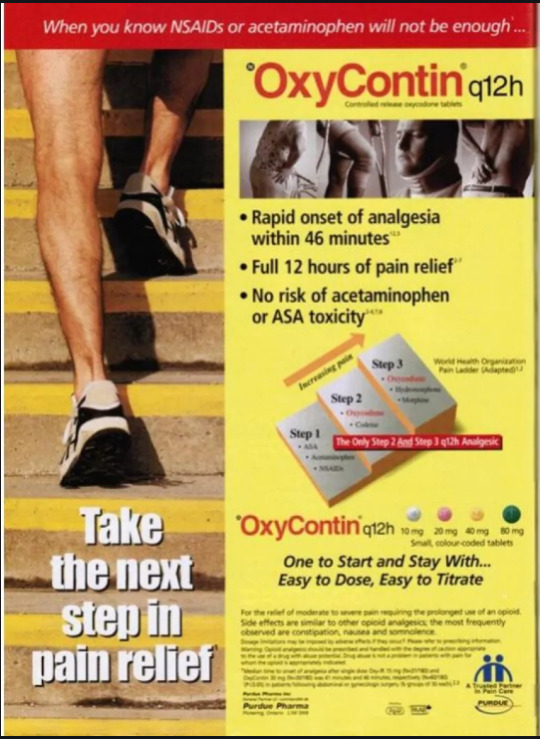
Wash, rinse repeat as we will see this in 5 to 10 years with Novo Nordisk & the GLP-1 drugs which we have no long term effects for (5 years) for people taking it for weight loss. The drugs have been shown to cause suicidal ideation, suicides, stomach paralysis, gastroparesis, pancreatitis, cyclical vomiting, severe nausea & diarrhea & cancer.
The medications are designed to be “taken for life” but given the side effects if an individual stops taking them, studies show that 66% of users gain all the weight lost back — given the drugs are $1400 a month & insurance companies only cover them for a certain period of time, this is critical as most people will not be able to afford to take these drugs for the rest of their lives & Novos patent will not expire until the next decade so FDA approved generics will not be available until then & compounded seamglutide — current generics & knockoffs — are non-FDA approved, unregulated & can result in contaminated doses, poisoning & death.
These drugs also suppress the bodys natural ability to release its own GLP-1, the bodys hormone signaling satiety after eating, so an individual will go from extremely excessive amounts of GLP-1 generated by the drugs to their own body not being able to secrete GLP-1 at normal levels which will cause & create withdrawals, ravenous increased appetite, food bingeing & disordered eating — all by design to then force the individuals back on the drug by any means necessary.
I still feel totally disturbed & unnerved.
I am 43 years old so I remember the Oxycontin ads. I remember Fen-Phen. I remember Vioxx. I remember the big tobacco Congressional hearings & lawsuits. I remember the NFL Congressional hearings & lawsuits.


And I know for an absolute fact we are going to witness the same hearings & lawsuits over the next decade with regards to these GLP-1 drugs.
We do not know the long term effects for people taking GLP-1 drugs for weight loss only, NOT for diabetes. We do not have longitudinal studies or data for the effects of taking GLP-1 drugs for weight loss long term which would be 5 years.
Yet the FDA has approved Ozempic for adolescents as young as 12 years old.
How many times do we need to see this movie?
How many people have to die for this cycle to stop happening every few years?
Or does nothing stop this under our Matrix controlled capitalist citadel hellscape?
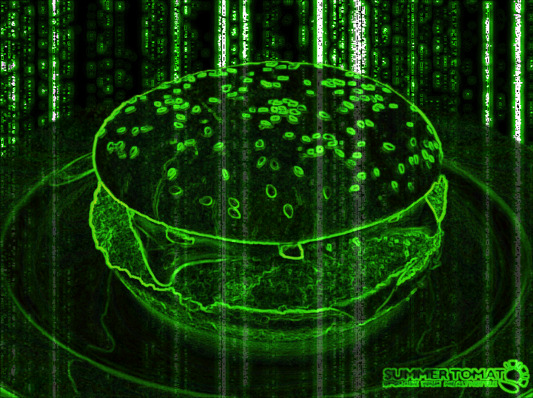

Statnews.com
“Novo Nordisk spent $11 million on meals and travel for thousands of doctors last year, federal records show, as part of its push to promote Ozempic and other weight loss-inducing diabetes drugs.
The pharmaceutical company bought more than 457,000 meals to educate doctors and other prescribers about its portfolio of drugs known as GLP-1 agonists, according to the newly released data from the Centers for Medicare and Medicaid Services.
Nearly 12,000 prescribers had food paid for by the company more than a dozen times last year. More than two hundred recorded more than 50 meals and snacks paid for by the company. One doctor, who is a frequent speaker for the company, recorded 193.”
In 2023, there was over $130 million worth of Ozempic ads shown on television with over 4,000 ads on Facebook & Instagram.


If you turned on a TV or scrolled on a cell phone or computer screen, the ad & the absolutely insipid & insufferable song were totally inescapable.
So, that's the volume of ads for the "miracle" MAGIC! weight loss drug...oh, oh, oh OZEMPIC!
What about the similarly ubiquitous & unavoidable ads for fast food & chain restaurant food?
No jarring juxtaposition or cognitive dissonance whatsoever.
Right?

I tracked the number of fast food & chain restaurant foods during 4.5 hours of one night of television watching WWE Raw & NBA on TNT:
•Olive Garden
•Ad: Limited Time Steak Gorgonzola & Chicken Marsala
•Number of times ad shown: 10 times
•Chick Fil A
•Ad: Seasonal Spicy Chicken Sandwich, Dr. Pepper & Waffle Fries
•Number of times ad shown: 8 times
•Applebees
•Ad: $9.99 Chicken Sandwich or Cheeseburger, Fries & Soda
•Number of times ad shown: 4 times
•Wingstop
•Ad: Music playing as door opens to Wingstop being delivered & friends inside an apartment then eating Wingstop wings, talking & laughing animatedly
•Number of times ad shown: 4 times
•Popeyes
•Ad: Wings with sauce
•Number of times ad shown: 2 times
•Burger King
•Ad: "Eat like a king when youre on a budget" 2 for $5 or 3 for $7
•Number of times ad shown: 2 times
•Taco Bell
•Ad: $5, $7 or $9 meals - $9 new double cheesy burrito
•Number of times ad shown: 2 times
•Dominos
•Ad: Medium 2 Topping Pizza including Thin Crust
•Number of times ad shown: 2 times
•McDonalds
•Ad: 2 for $5 - McChicken or Cheeseburger with Fries
•Number of times ad shown: 2 times
4.5 hours of TV. Nine fast food restaurant & chain restaurants advertised. For a total of 36 ads.
Literal definition of brainwashing.
Psyops.
Literally psychological operations & psychological warfare.
Brainwashing ads for the public to consume food literally designed to be addicting, stuffed full of synthetic chemicals & toxins shown literally dozens & dozens of times within just a few hours of TV — a WWE weekly wrestling program & an NBA basketball game.
Closeups, cheese pulls, food porn, lingering shots, zoom ins, slow motion, endless repetition, loud music, jingles endlessly nauseatingly replayed, people laughing eating having fun while eating & devouring fast food & chain restaurant food, eyegasms, mouthwatering, super appetizing, endorphin rush, cheap, sale, dollar menus, value deals, value meal, limited time, bogo, im lovin it, have it your way, yo quiero taco bell, noone outpizzas the hut, finger lickin good, bdubs, eatin good in the neighborhood, dollar ritas, endless chips, endless fries, same ad three times within one single solitary commercial break, alluring ads, seductive ads, literally hypnotic ads…
Ads literally designed, filmed & shot specifically to induce & cause cravings, desire, endorphin rushes, shortcircuited thinking, hunger pangs, need to be satiated & satisfied, impulse ordering, racing to doordash app, gotta have crunchy, crispy, salty, cheesy, fried, bacon-y, cheesy, melty, meaty, decadent, juicy, thick, succulent, delicious, gotta have it, lighting up your reward system, as addictive as literal cocaine, crossing the blood brain barrier, ordering for every game, every week, every weekend, every day, every mood, happy moods, sad moods, bored mood, busy moods, socializing moods, fun moods, friend mode, get together mode, family mode, gaming mode, hangout mode, its the weekend mode, tgi friday mode, i need a break mode, im going to reward myself mode, treat yo self mold, yolo mode, cheap instant endorphin rush mode, instant pick me up mode, instant mood enhancer mode, eat my feelings mode…
Capitalist exploitative cunts.
TheBeet.com
“The ads during your favorite NFL game (or any other sporting event) are full of close-ups of all sorts of junk food loaded with heart-bursting saturated fat. Researchers have linked these marketing campaigns with having a role in contributing to America's persistent obesity crisis.”
“According to Yale researchers, there is a direct relationship between ads and eating habits. Hedy Kober, a Yale Associate Professor who runs the Clinical & Affective Neuroscience Laboratory there, looked at the effect of exposure to food cues (both virtual and real) on cravings, eating behavior, and weight gain. In reviewing 45 studies that took data from 3,300 participants, Kober and her researcher told NPR they saw a direct connection between food cues and eating behavior.”
“We found very, very strong relationships between reactivity and cues and weight and eating," Kober told NPR.
The findings, which were published in the journal Obesity Reviews, one would have thought might lead regulators to consider banning advertising food that is harmful to an American public that is significantly overweight. Yet that was over six years ago. Nothing happened.”
They make money off of sickening and poisoning us with the food they are selling us that they purposely make addicting that we then become addicted to that then poison, sicken and kill us all while making them billions & trillions of dollars in profit.
“Of all the calories we eat, and Americans on average eat over 3,600 calories a day (a 24 percent increase since 1961) nearly 60 percent of them are in the form of highly processed or junk food.
If we cut out those unhealthy calories, health advocates and nutritionists believe, we could lower our risk of lifestyle diseases such as type 2 diabetes, heart disease, obesity, high blood pressure, and certain weight-related cancers. The CDC has identified no fewer than 13 types of cancer that are tied to obesity.
Because our food systems have engineered the majority of our packaged foods to contain fewer nutrients, yet more calories, more simple carbs, and more saturated fat that can clog our arteries and lead to heart disease, it means that the same regulators who allow food makers to create chips that are hard to stop eating are also allowing these junk food makers to come into our living rooms day after day and night after night to pump up desire and cravings and remind us to want these crappy foods.
Like cigarettes, they may be killers but they are hard to quit.
And the food ads are shot up close, like food porn, pulling apart a slice of pizza that steams and melts in a way designed to make our mouths water.
And fast food ads tell you that the social fun of watching your team with friends also must involve consuming large amounts of calories and unhealthy saturated fat.
We see cheerful pizza delivery guys opening doors to family gatherings and bonding experiences surrounding cheesy foods, carb-centric chips, stacked burgers with bacon, cheese, and fries, and innocent-looking frothy pints of beer.
Now that I am avoiding these types of foods, I notice that when you watch TV, especially football, they are ubiquitous, unavoidable and absolutely everywhere…”
Food Highs & Food Comas

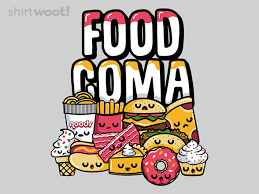
They WANT people sick, obese, overweight, lethargic, sluggish, disordered, numb, compulsive, obsessive, addictive, mindless, slavish, overindulging, excessive, apathetic, indifferent, overcompensating, binge eating, binge snacking, overeating, eating fast food every day, doordash every day, delivery every day, sit down restaurant every month, pizza, wings, burgers, chicken, sandwiches, hoagies, subs, fries, mozz sticks, endless fries, 1/2 price apps, nuggets, tacos, burritos, chalupas, force of habit, emotional eating, eating emotions, stress eating, eating when bored, distracted eating, mindless eating, portions quintupled since the 1950s, super sized, extra large, large, upgrade, doordash order add ons, carvel, dairy queen, ritas, manic mondays, delivery fridays, order out, order in, sit down, eat out, take out, menus, eating chemicals, gagging it down, gagging it up, mystery meat, school cafeteria, hospital cafeteria, food that makes you sick, leftovers, seconds, thirds, buffets, endless meals, endless apps, endless pancakes, birthday meals, instant endorphins, endorphin rush, cheap endorphins, food high, sugar high, addicts…
I haven't even mentioned subsidies yet.

US government subsidizes meat, dairy, eggs & sugar.
This is why dairy is in everything — ask yourself why casein — that contains milk — is used to bind flavoring to POTATO CHIPS when vegan binding agents work better.
Subsidies.
Killing fields…
All of the tentacles in capitalism are endless. Endless industrial complex pipelines. All leading to money, pain, misery, suffering death… And money.
The government subsidizes the industries that pay them.
Its as simple, nebulous, nefarious & fucking evil as that.
Subsidies artificially increase the cost of goods enough to be profitable while still being affordable. The agricultural lobby created the USDA which then set food agendas like the completely bogus & refuted by science “Food Pyramid” that enriched…the agricultural lobby.
It is that circular & insidious.
The United States grows 2/3 of the world’s food yet 1/2 of that food is wasted — thrown away & never consumed.
40% of waste in landfills in the US is food that has been thrown away.
There is no corresponding Big Broccoli to Big Ag.
That is what subsidies are about.
Its not about competition, keeping farmers employed, exports or tariffs.
Its about what its always about in the death cult known as capitalism…
Money.
Back to Ozempic...a weight loss drug literally CAUSING eating disorders!
Ozempian Eating Disorders
NBC News
Over the past six months, psychologist Tom Hildebrandt has seen an increase in patients with eating disorders who are taking popular weight loss drugs like Wegovy or Zepbound.
A growing number of doctors are concerned that the medications are triggering or worsening eating disorders in some people.
One recent study, based on an analysis of adverse event reports submitted to the Food and Drug Administration, found a greater risk of abuse among patients taking semaglutide, the active ingredient in Wegovy and Ozempic, compared to other weight loss drugs.
People don’t need to abuse the new drugs, however, to develop eating disorders, Keshen said. He’s seen eating disorders develop in people who take the drugs as prescribed.
The Collaborative of Eating Disorders Organizations, whose members provide treatment or support for people with disordered eating, has called for doctors to screen people for conditions such as anorexia, bulimia and binge eating disorder before prescribing the drugs for weight loss.
McElroy and her colleagues published the story of a woman who abused a GLP-1 in the Journal of Clinical Psychopharmacology. Her team first met the patient when she was hospitalized for suicidal thoughts.
The woman lost 50 pounds in nine months and eventually confided that she often took more medication than prescribed “when she felt she ate too much.”
Hildebrandt said he’s concerned that doctors aren’t adequately warning people about the potential risks of eating disorders before prescribing the medications.
Some doctors are especially concerned about the potential for abuse or eating disorders in adolescents. Wegovy is approved for use in children ages 12 and up.
The prevalence of eating disorders has grown sharply in recent years.
Eating disorders can be life-threatening. Anorexia has the highest mortality rate of any psychiatric disorder; about 5% of people with the condition die within four years of diagnosis.
Most Wegovians are Women
NYT.com
81 percent of the people taking Wegovy in the United States in 2022 were female, according to data from its manufacturer, Novo Nordisk.
A researcher whose work contributed to the development of what are called GLP-1 receptor agonists, like Ozempic, believes that the loss of food joy while on these drugs is not only a genuine loss but also a major reason patients tend to stop taking them.
“What happens is that you lose your appetite and also the pleasure of eating,” and “there’s a price to be paid when you do that,” said Jens Juul Holst, a professor of Biomedical Sciences at the University of Copenhagen. For some people, “once you’ve been on this for a year or two,” he said, “life is so miserably boring that you can’t stand it any longer and you have to go back to your old life.”
With Ozempic and Wegovy — again, taken purely for weight loss, rather than treating diabetes or other health conditions — little attention has been paid to the plight of people who have long been accustomed to ignoring our voice of hunger, inasmuch as we exhibit disordered eating or even suffer from full-blown eating disorders.
Despite the high prevalence of such problems — including in children and adolescents, with disordered eating affecting more than one in five worldwide — the potential of these drugs to push people into dangerous territory is rarely confronted soberly.
Disordered Eating In A Syringe
Styletto Mag UK
"Thinness is the ultimate goal, and happiness and health come in the form of a syringe or a starvation diet. We need to take a stand—against the diet culture that profits from insecurity, against the media that perpetuates harmful ideals, and against the normalisation of disordered eating."
Stapled Tongues & Paralyzed Stomachs

LA Times
Typically used to treat Type 2 diabetes and other conditions, Ozempic, Wegovy and other semaglutide and liraglutide medications are part of the latest wave of weight loss solutions that people, in particular women, are clamoring to get their hands on. Whether that’s through their doctor, a medispa, a pharmacy in Tijuana, a website or by any other means. The popularity of Ozempic continues to skyrocket, despite growing concerns over the drug’s side effects, including thyroid cancer, muscle loss, suicidal ideation, stomach paralysis and other gastrointestinal issues. It harkens back to other weight loss “solutions” from the not-so-distant past: Fen-Phen, Herbalife, Belviq, Hydroxycut, the Atkins diet, the keto diet, jaw wires, flat tummy teas, and innumerable other drugs, fad diets and products, which have all had their moment.
Anything that promises a thinner body will find a hungry audience.
“In our family, with all our experimental diets and being Mexican, when something like [Ozempic] comes out, it makes it not scary for us,” said Aguilera, who started trying to lose weight at age 11. “Me and my mom have gone together to get our tongues stapled. I’ve injected so many shots into my stomach, I can’t even tell you what they were. We were never afraid of trying something new.”
Pedroza stopped taking Ozempic in early October after his body began to reject food. The smell inside a restaurant causes him extreme nausea, and he now struggles to swallow anything he tries to eat. He’s worried the drug gave him stomach paralysis. “It’s scaring me because I know that I need to eat,” he said.
A Clockwork Orange: Eating Disorder in an Injection
Guardian.com
It’s so controversial because of the way it works: by triggering a chemical repugnance to food itself. After being injected with Ozempic, a user could try to imagine a calorically-dense, half-pound Baconator bacon cheeseburger from Wendy’s, and their body physically revolts, with spasms of nausea and waves of ill feeling. It’s the chemical realization of a behavioral psychologist’s wildest dream; A Clockwork Orange for junk food, an eating disorder in an injection.
Online, forums are chock full of stories from Ozempic users whose relationship with food has changed, not only physiologically, but psychologically. “I miss enjoying food and going out to eat,” says one. Another is even more blunt, lamenting: “I hate food.”
There is, perhaps, something sinister, and even a little sci-fi, about a wildly popular weight loss treatment that works, whether in whole or in part, by making food itself disgusting.
Pavlovian Ozempian Salivating Dogs
In due course of treatment, the desire or stimulus itself is exterminated – “beyond the zero”, as Pavlov famously put itin his 1927 lecture on the conditioned reflexes of dogs.
Thyroid Cancer to be Thinner
Animal studies have linked Semaglutide to an increased risk for thyroid cancers, as well as pancreatitis and gallstones. Some law firms already seem to be gearing up to file suits on the basis of these adverse effects.
Weight Loss or Water Loss?


She compares Ozempic to the weight-loss pill Alli, still sold over the counter today, which was “huge news” in the 90s for its claim to stop fat absorption. “What happens is very frequent, very colourful diarrhoea, but of course they say: ‘You’ve lost weight’.”
That is a common side effect of Ozempic, too – alongside nausea, vomiting, constipation and fatigue. Some people report becoming intolerant to most foods, and even water. “In short, it ruined my life,” a 26-year-old Londoner said recently of her five-month experience: she felt constant nausea and often vomited after waking. But, for some, even that is worth it. “I think a part of me felt like I deserved to feel awful as a punishment for my weight,” said the woman.
“It sounds to me that what people are doing, culturally and psychologically,” she says, “is imagining [being overweight] as a chronic disease that then requires chronic treatment for the rest of their lives.”
“Highly processed foods are engineered to make us want them: They have the sugar, fats, salt,” says Chrzan. The optimal combination of these for maximum deliciousness is sought after by market researchers and flavour scientists as the so-called “bliss point”.

Ozempic could prove to have a lasting impact on our hormonal pathways, and other internal processes relevant to dietary intake. Certainly, doctors have found that stopping Ozempic can cause blood sugar to surge and cravings to return, sometimes amplified. Regulatory approval also does not guarantee safe consumption. In 2020, the diet drug Belviq was withdrawn over a potential cancer risk that “outweighs the benefits”, a full eight years after it was approved by the US Food & Drug Administration.
There’s one fact about Ozempic that might appear to negate the entire endeavour: People often gain back any weight lost while on the drug as soon as they stop taking it – locking them into a costly, indefinite commitment to medication.
Instead of learning how to eat and be active – how to nourish and accept the ever-changing body we’re in – we are effectively paying to make the problem go away.
“I think we’re going to look back on this and view it with the same concern and disdain that we now view the prescription of cigarettes and benzedrine for weight loss – we’re going to see how treacherous it really was,” says Christyna Johnson, a “non-diet” dietitian based in Texas.
Doctors in the UK as well as the US receive nominal instruction in nutrition, and next to nothing in disordered eating – meaning they, too, can weight medicalised responses and cures over holistic ones, or prevention.
"I'm Just Identifying...'I'm Eating Eggs'"
“I don’t think people anticipate that they’re going to be so repulsed by food as they embark on their Ozempic journey,” says Johnson. “You can’t wrap your head around it: ‘I’m putting something in my mouth that I know I enjoy, and I’m getting zero pleasure out of it… I’m just identifying: I’m eating scrambled eggs’.”
Ozempic seems to superficially, artificially transcend the matter of willpower, indulgence, restraint and virtue.
Kate Moss’s quip that “nothing tastes as good as skinny feels” may have caused outrage, but it captured the deadpan nihilism of the 90s and heroin chic.
Now slimming drugs are ushering in a return of that era’s extreme thinness – but it is telling that the slogan, updated for 2020s, lacks the same wry provocation: “nothing tastes as good”.
These days, we are barrelling towards dystopian chic. Indeed, one feature of a dystopia is the sense of no tomorrow: Ozempic promises thinness for today, as long as you can afford it.
Anorexia, Bulimia & Laxative Abuse in an Eating Disorder Needle
Beateatingdisorders.org.uk
"There must also be more education about the dangers of using medication to lose weight. It’s very alarming that patients in the clinical trial of Semaglutide experienced side effects such as nausea and vomiting, which could potentially trigger an eating disorder or worsen symptoms for someone who is already unwell."
"I have to remember to drink water"
Jezebel
New York published a feature about how trendy Ozempic and semaglutides generally have become with the headline “Life After Food?”
Interviewees reported a severe lack of appetite; one source said they even had to remind themselves to drink water.
Another said, “It’s really fun for [already-thin women] to have their jeans hang off of them like they’re a Hadid. There is an addictive quality to it.” An actor described herself as less anxious because she was less hungry, and said Ozempic allowed her “to be casual about food”: “I can just have one bite, or two bites, or three.”
The off-label use of semaglutide just add another tool to the stockpile of ways to self-destruct with an eating disorder.
If your side effects are so bad you can’t (or don’t) eat you should not be taking them.
It would be one thing if people who got semaglutide prescriptions for weight loss were given informed consent, like, “By the way, taking this medication puts you at greater risk of developing a potentially deadly eating disorder,” Dennis said.
“But nobody’s getting that in their informed consent. Nobody at the primary care office or the endocrinologist’s office or the family practice office is being told, ‘Yes, you can try this medication, but please be aware that one of the potential side effects is the development of an eating disorder.’”
“So all of these people are still going to have their eating disorders and obsession with weight loss and obsession well after they’re off of their one-year, two-year, three-year course of Ozempic.”
Using Ozempic and other semaglutide medications for off-label weight loss is simply recycling the worst parts of diet culture and packaging them in a syringe with a doctor’s approval.
Ozempic Black Market
“We know that people have been able to get hold of Ozempic when they shouldn’t, for example by amending weight details when requesting it from online pharmacies, or getting it through the black market,” says Tom Quinn, head of external affairs at Beat, the UK’s leading eating disorders charity.
“Eating disorders will not suddenly be improved by the person affected losing weight – while it might bring their BMI [body mass index] down in isolation, it will do nothing to address the eating disorder and could make symptoms worse.”
While those suffering from an eating disorder might be lured in by the promise of quick weight loss, there’s a lingering question mark over what happens if and when they stop taking the drug. “If somebody gains weight after their prescription finishes, this could trigger feelings of shame and guilt, which could contribute to an eating disorder developing or a relapse,” adds Quinn.
However, the risks attached to taking these drugs off-label, without proper medical supervision, are high, with potential side effects including gallbladder disease, kidney failure, pancreatitis, and changes in vision. And those are just the ones we know about; given how new these drugs still are, there’s no concrete research on the long-term effects. For those with eating disorders, though, the psychological risks are arguably higher. By using these medications to change how we feel about ourselves, we’re mimicking the behaviour seen in substance use disorders, where substances are used to manage internal discomfort. It’s alarming, and the potential medical consequences are enormous. As well as the risk of provoking a relapse or prolonging recovery from an eating disorder, there are fears that physical side effects won’t put people off but will rather only strengthen a reliance on the drug. Nausea, vomiting, abdominal pain, diarrhoea and constipation also disrupt regulated eating, which is generally considered to be the most healthy approach to achieving and maintaining a healthy weight and is the mainstay of the treatment of eating disorders. For some, seeing the physical changes – especially those that society has come to idealise – and the attention they bring can drive the desire to replicate the same results, despite the risks. This visibility creates a feedback loop – people using the drug, becoming more noticeable, and others wanting to follow suit. However, greater changes are urgently needed at a higher level in order to combat the rise of people accessing weight-loss drugs without proper prescriptions. Evidently, the restrictions around them are far too lax. Safeguards should be in place for the prescription of these medications, including a requirement for comprehensive assessment of physical and psychological parameters before treatment is started. This should include verified BMI and screening for eating disorders.
♪"Ohhhhh, its magic"♪...hypoglycemic seizures?
Reddit
"My family is deeply concerned about my mom, who has been on Zepbound. It was initially prescribed for weight loss, but it’s escalated into something much more dangerous. She’s now eating only about 500 calories a day, has lost significant muscle mass, and is showing clear signs of malnutrition. She moves like someone decades older than her age.
Despite promising to stop, she’s continuing the medication, and it seems to have triggered or exacerbated disordered eating behaviors. It’s become so obvious that even people outside our family have noticed how unwell she looks. Her doctor hasn’t stepped in, and we’re starting to feel like they’re enabling this situation by continuing to prescribe the medication without addressing these risks.
This concern is amplified by my wife’s experience with the same class of drugs. When she decided to stop taking semaglutide, her doctors actually discouraged her from getting off it, even though she was having side effects. It felt like they were more focused on keeping her on the medication than on her overall health.
Today, my mom fell and likely had a hypoglycemic seizure. My dad, who is usually very stoic, is panicked. We’re arriving tomorrow for the holiday, and at this point, we’re unsure what to do."
Ozempic Manic Mania
NPR
In July, the European Medicines Agency said that it was looking into the risk of thoughts of self-harm and suicidal thoughts with the use of Ozempic and similar drugs. As of July 11, the regulator, Europe's FDA, was evaluating more than 150 reports.
The FDA hasn't taken that step. For now, the agency is monitoring the situation. "We continue to conclude that the benefits of these medications outweigh their risks when they are used according to the FDA approved labeling," spokesperson Chanapa Tantibanchachai said in an email to NPR. She noted that weight-loss drug Wegovy, which contains the same active ingredient as Ozempic, semaglutide, includes a warning about suicidal thoughts on its label.
NPR analyzed the FDA's adverse event reporting system, or FAERS, and learned that the agency has received 489 reports of patients experiencing anxiety, depression or suicidal thoughts while taking semaglutide drugs, including Ozempic, Wegovy and Rybelsus.
In 96 of those reports, the patient had suicidal thoughts. Five of them died.
These kinds of incidents often don't happen during the drug's clinical trials because those studies include relatively small numbers of patients who are taking the drug for a limited time. Once a drug is on the market, millions of patients might take it for years.
There's another limitation to the preapproval studies: Who gets to be part of them. Dr. Amy Rothberg, an endocrinologist at the University of Michigan, says patients recruited for the Ozempic clinical trials were screened for depression, anxiety and suicidal thoughts. They would have been excluded from participating.
Less Desire for Food, Sex And Life
Healthline.com
The most commonly reported symptoms of “Ozempic personality” are:

Worse mood
Increased feelings of anxiety and depression
Feelings of anhedonia, or lacking an interest in previously enjoyed activities
Decreased libido (less interest in sex)
These negative feelings are generally attributed to changes in the dopamine or “reward center” of the brain. But it’s not entirely clear how GLP-1 drugs are interacting with dopamine in the brain.
“It doesn’t surprise me that there are overall changes in people that are on these drugs. I think some of them are probably subtle, but in animal models, these drugs turn down almost any motivated behavior that we can imagine,” said Daniels.
This Is Your Sex Life...On Ozempic

Wired.com
SHANE DESMOND HAS been taking Wegovy only since the beginning of January, but he’s already noticing benefits. For one, he has dropped about 18 pounds from his starting weight. There’s something else: His libido has improved. At 51, Desmond says it was normal for him to feel in the mood maybe once a week. Now, it’s almost daily. “It kind of took me by surprise,” he says, considering he usually experiences low libido in the winter. He says there have “definitely been some improvements” in his sex life with his husband.
For Julie, a 47-year-old started Wegovy in March 2023 and switched to Zepbound in August last year. She has lost about 60 pounds, down from a starting weight of 276.
The weight loss has made her feel more physically comfortable in the bedroom, making sex with her husband more enjoyable. “If I’m on top, and I have weight resting on my knees or hips, it doesn’t hurt as much,” she says. “If I’m on all fours, my wrists don’t hurt from holding myself up, which makes everything better.”
Certain positions are quite literally a better fit now, she says. And the weight loss has made her more open to trying or suggesting those positions.
Ozempic Magic Deaths
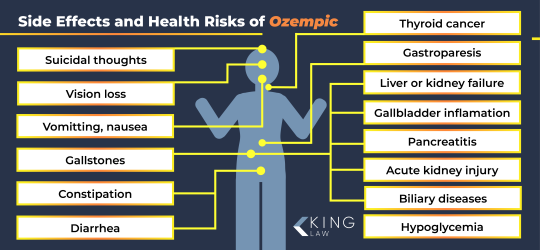
DailyMail.com
Weight loss shots like Ozempic have been linked to 162 deaths in the US, DailyMail.com can reveal.
One of the victims was a 45-year-old woman who choked on her own vomit while on Mounjaro, a rival drug that works the same way.
Another involved a 23-year-old man who died from vomiting, nausea, and a rapid heart rate after taking Wegovy.
The fatalities were logged in the FDA's FAERS database, which is used to monitor the safety of drugs after they are approved and on the market.
Surveys from this year suggest that six percent of US adults — or 15.5million people — have now tried a weight loss drug.
In FAERS, a total of 10,000 reactions were classified as 'serious', or where a patient was hospitalized or suffered from a life-threatening event.
Among the new cases reported in the past six months was a 30-year-old man on Ozempic who was hospitalized with pancreatitis — a serious diagnosis where the pancreas becomes inflamed and causes pain in the abdomen which some patients describe as being 'worse than childbirth'.
Juanita Gantt was found by her husband Robert unconscious one day in October 2023 and rushed her to the hospital to find she had a severe case of colitis requiring the removal of her colon. She was faring well on the medicine for months until she suddenly collapsed at home and was found unconscious by her husband.
Doctors found part of her intestine had died due to a condition called ischemic colitis, requiring her colon to be removed. She later went into cardiac arrest.
The woman now has to use a drainage pouch — a bag used to collect waste from the intestines when the normal route is no longer functional — for the rest of her life when she goes to the bathroom, which she says she wouldn't have needed if she had never taken Ozempic.
Australian Trish Webster, 56, died after using Ozempic to lose some weight before her daughter's wedding from a blocked bowel after months of severe vomiting and diarrhea.
A decade from now, Ozempic, Wegovy, Zepbound & Mounjaro — the heavily hyped GLP-1 weight loss drugs currently touted as the newest so-called “miracle” — will absolutely be facing the same controversies, lawsuits, dangerous long-term side effects, deaths, Congressional hearings, regulatory oversight for online medspas & telehealth companies prescribing compounded semaglutide with a filled out online form without even requiring a video appointment with a doctor prior to filling the prescription, settlements & yet another societal reckoning — just as we have previously collectively done after the fact once again when it was too late — for OxyContin, Fen-Phen, tobacco, nicotine, overly processed foods, fast food, sugary beverages, alcohol, Vioxx, Celebrex, concussions, CTE, MSG, transfat & a host of other dangerous medications, chemicals & additives in our capitalist obsessed dehumanized dystopia that prioritizes money & profits over safety, protection, prudence, caution, restraint & actually learning from the mistakes of our VERY recent past always to only repeat them again just a few short years later when the next craze, fad, mania & trend hits and only when actually suffer & die first do we collectively momentarily pause as a society, decide that we didnt do enough regulatory checks, there wasnt enough oversight, compliance, ensuring the well being of society, waiting for long term safety & efficacy before allowing millions to potentially harm, sicken, destroy & kill themselves whether for vanity, purported health, so-called character building & teamwork, pain relief, recovery, social benefits, cool or IT factor, Hollywood factor, keeping up with the joneses & flexing for the gram…
There will always be a skinny jab, a magical cure all, a magic pill, a sought after elixir, a fountain of youth, a pain reliever that also induces euphoria, something that promises results without all the work, thinness in a bottle, tiny waist in a needle, confidence in a vial, salvation through microdosing Ozempic dragging out every last drop through insulin needles jabbed into your stomach, compounded semaglutide sodium made in an unregulated Chinese lab, anything to be fit skinny on trend fashionable riding the hype train jumping on the bandwagon not being left out no FOMO in the mix status symbol ego confidence hot new thing one of millions everyone else is doing it…


#ozempic#semaglutide#wegovy#glp1#big pharma#obesity#health at every size#body neutrality#diet culture#ultra processed foods#fast food#big tobacco#nfl#opiods#brainwashing#food additives#corporatism#addictive#advertising#junk food#libido#disordered eat1ng#diet pills#dystopian#hims
3 notes
·
View notes
Text
Is your bacon breakfast a health trap? 😱 Sodium nitrite and nitrate could be raising your cancer risk! Tap to watch the shocking truth and share to save a life! #SodiumNitrite #HealthRisks #FoodAdditives #ProcessedMeats #HealthyLife
#cancer risk#Food Additives#health Risks#Healthy Eating#processed meats#Sodium Nitrate#Sodium Nitrite
0 notes
Text
it’s not just carbs, or the former “staff of life”.
it’s what corporations do to these once staple foods.
I was in bed all the time, chronically fatigued, depressed, and couldn’t get anything done. When I changed my diet and avoided MODERN bread, I was not only able to get out of bed, I’ve begun a new, physically demanding career as a Licensed Massage Therapist.
the problem is the chemicals they put on crops, the genetic modification and breeding of wheat and rice, and most of all, the over processing of wheat and rice. They rob these foods of their nutrients and then add chemicals back in. It’s the over processed, pre-digested qualities of these foods.
it’s all for corporate products,
and they are addictive substances, BY DESIGN. One thing I’ve learned from addicts…they will defend their addiction, no matter how objectively horrible it is.
‘bread is bad for you’ ‘rice is bad for you’ sorry im not subscribing to the idea that staple grains that have been integral to cultures for centuries are evil. i love you carbs
#Over processed foods#celiac sensitivity#corporate greed#food addiction#food additives#chronic fatigue
102K notes
·
View notes
Text
Food Texture Market Global Market Size 2025–2035
Market Overview
The food texture market was valued at USD 15.4 Billion in 2024 and is projected to reach USD 29.85 Billion by 2035, expanding at a CAGR of 6.2% from 2025 to 2035. This market encompasses ingredients like emulsifiers, stabilizers, thickeners, and gelling agents used to enhance and modify the texture and consistency of foods across dairy, bakery, beverage, and convenience segments. Request Sample- https://www.metatechinsights.com/request-sample/1821
Market growth is driven by rising consumer demand for plant-based, clean-label, and functionally enhanced foods. The popularity of processed and ready-to-eat foods has increased the need for innovative texturizing agents that improve sensory appeal, shelf life, and product stability. However, the high cost of natural alternatives and regulatory barriers may hinder growth in emerging markets.
Key Market Drivers
Increased preference for indulgent textures in convenience and packaged foods.
Rising demand for clean-label, natural, and plant-based food solutions.
Growing usage of hydrocolloids, emulsifiers, and gelling agents in new food formulations.
Advancements in food biotechnology enhancing texturizer sustainability and functionality.
Full Report - https://www.metatechinsights.com/industry-insights/food-texture-market-1821
Key Challenges
High production cost and limited availability of natural texturizing agents like pectin and xanthan gum.
Affordability and supply chain limitations in cost-sensitive emerging regions.
Regulatory complexity surrounding the approval of novel texturizing compounds.
Market Dynamics
Rising consumer awareness of texture as a critical element of food quality is pushing innovation.
Texturizing agents are now used not only for mouthfeel but also for stabilizing product structure and extending shelf life.
Clean-label trends are promoting R&D in plant-based, bioengineered, and enzyme-based solutions.
Segment Overview
By Type: Hydrocolloids (e.g., pectin, carrageenan), emulsifiers, starch, gelatin agents, anti-caking agents. Hydrocolloids dominate due to multifunctional use in thickening, gelling, and stabilizing.
By Function: Thickening, gelling, emulsifying, stabilizing, coating, binding, moisture retention, and mouthfeel enhancement. Thickening and gelling are central to soups, sauces, dairy, and desserts.
Buy Now- https://www.metatechinsights.com/checkout/1821
Regional Insights
North America leads due to advanced food processing technologies and consumer demand for premium textures and clean-label products. Significant R&D investments are driving innovation in texturizing solutions.
Asia-Pacific is witnessing rapid growth due to rising income levels, urbanization, and evolving food preferences. Innovations like seaweed-based and fermentation-derived texturizers are gaining ground.
Emerging economies are investing in localized production and cost-effective alternatives to improve accessibility.
Competitive Landscape
Major players like Cargill Inc., Ingredion Incorporated, Kerry Group, and DuPont & Co. dominate the landscape. Key strategies include:
Product innovation in plant-based and bio-derived texturizers.
Strategic mergers and acquisitions to enter new markets and expand portfolios.
Focus on enzymatic and microbial texturizers with enhanced sustainability and performance.
The competitive intensity is high, with players actively pushing the boundaries of biotechnology, clean-label ingredients, and sustainable sourcing to address changing global consumer demands.
#Food texture market#food texturizing agents#hydrocolloids#emulsifiers#food additives#processed food trends#clean label ingredients#biotechnology in food#food stability#functional foods#nutraceuticals#texture enhancers#global food industry
0 notes
Text
Interesting findings. The report is careful to state associative findings not causative findings. Worth further study, I think.
0 notes
Text
Propylene Glycol in Food: A Comprehensive List
Propylene glycol is a versatile chemical widely used in many industries. It is colorless, nearly odorless, and tasteless, making it a popular choice for various applications. This product plays a significant role in preserving moisture and improving texture in many items. In the food industry, it is commonly found in processed items like baked goods, condiments, and dairy products. Its ability to…
#Food additives#Food safety concerns#Harmful chemicals#Preservatives in food#Propylene glycol dangers
0 notes
